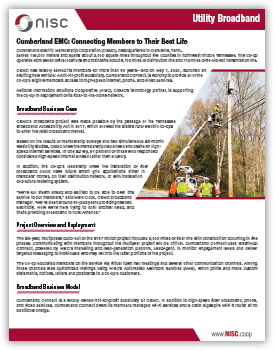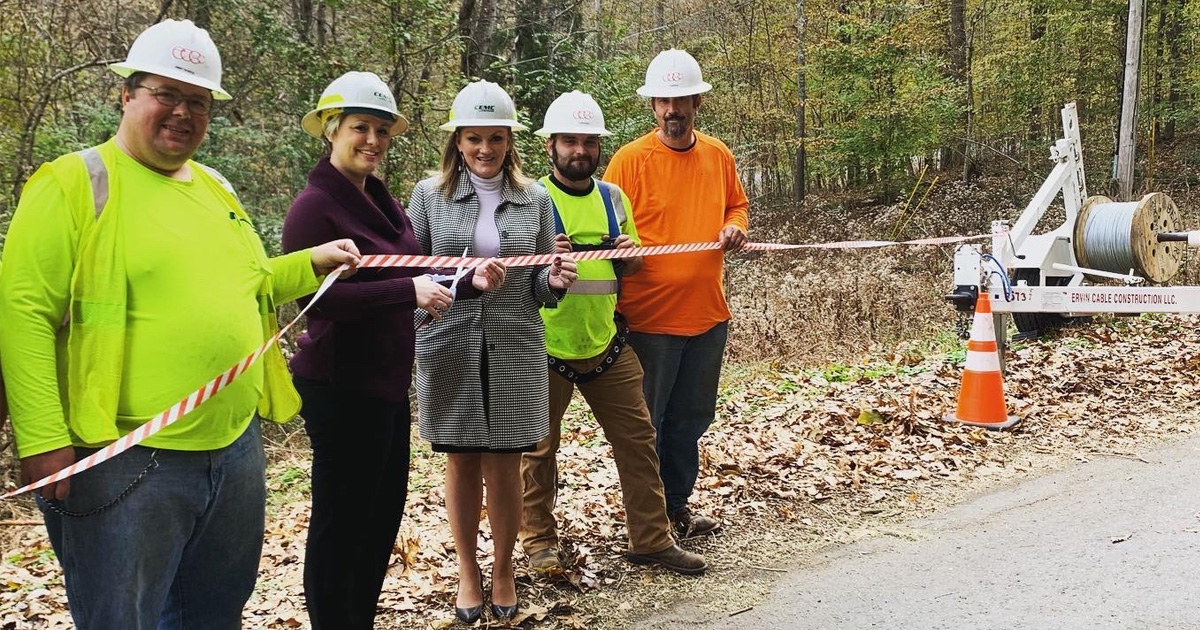Cumberland Electric Membership Corporation (CEMC), headquartered in Clarksville, Tenn.,
serves 105,000 meters and spans about 2,000 square miles throughout five counties in northwest middle Tennessee. The co-op operates from seven office locations and maintains about 8,100 miles of distribution line and 112 miles of 69-kilovolt transmission line.
 |
| Click here to download |
CEMC has reliably served its members for more than 80 years—and on May 1, 2020, launched an exciting new venture: A not-for-profit subsidiary, Cumberland Connect, is working to provide all of the co-op’s eligible members access to high-speed internet, phone, and video services.
National Information Solutions Cooperative (NISC), CEMC’s technology partner, is supporting the co-op in deployment of its fiber-to-the-home network.
Broadband Business Case
CEMC’s broadband project was made possible by the passage of the Tennessee Broadband Accessibility Act in 2017, which allowed the state’s rural electric co-ops to enter the retail broadband market.
Based on the results of membership surveys and two simultaneous six-month feasibility studies, CEMC knew the membership had a need and desire for high-speed internet services. In one survey, 91 percent of those who responded considered high-speed internet a need rather than a luxury.
In addition, the co-op’s leadership knew the installation of fiber broadband could have future smart grid applications either in members’ homes, on their distribution network, or with installation of a future metering system.
“We’re full steam ahead and excited to be able to offer this service to our members,” said Mark Cook, CEMC broadband manager. “We’ve been around 80-plus years providing needed electricity. Now we’re here trying to fulfill another need, and that’s providing broadband to rural America.”
Project Overview and Deployment
The six-year, multiphase build-out of the $197 million project includes 5,000 miles of fiber line with construction occurring in five phases. Communicating with members throughout the multiyear project will be critical. Cumberland Connect uses SmartHub Connect, powered by NISC’s marketing and lead-generation platform, LeadAgent, to monitor engagement levels and deliver targeted messaging to individuals who may fall into the latter portions of the project.
The co-op educated members on the service via virtual town hall meetings and several other communication channels. Among those channels was customized mailings using NISC’s Automated Mailroom Services (AMS), which prints and mails custom statements, notices, letters and postcards to a co-op’s customers.
Broadband Business Model
Cumberland Connect is a wholly owned not-for-profit subsidiary of CEMC. In addition to high-speed fiber broadband, phone, and video services, Cumberland Connect offers its members managed Wi-Fi services and a Calix GigaSpire WiFi 6 router at no additional charge.
With an enhanced focus on customer service, CEMC utilized NISC’s iVUE Connect solution for their broadband project. The solution makes it easier for co-op staff to assist customers by quickly finding information in a secure, web-based, user-friendly environment. iVUE Connect is a unified solution that provides telecommunication services like triple play and auto-provisioning while also supporting the needs of the contemporary utility.
Using iVUE Connect, CEMC customer service representatives are handling both electric and broadband service orders
“When a member calls or walks into our lobby with an electric question or broadband service request, it’s a one-stop-shop with that customer service rep,” said Beau Baggett, CEMC manager of member experience.
The co-op had worked in NISC’s iVUE customer care & billing software to complete service orders on the electric side for more than 10 years, but customer service representatives learned new, more efficient workflows utilizing iVUE Connect’s broadband functionality.
Challenges
The project’s launch was extremely timely, arriving when many people were working from home and children were completing schoolwork online due to the COVID-19 pandemic. The physical distancing efforts also pushed training to be performed virtually and prompted a slight project delay while doing initial pre-launch installations.
The pandemic also disrupted a critical training window for the co-op’s employees, when they were learning to execute broadband service orders via iVUE Connect. Much of the training was moved to virtual, as the co-op closed its front lobbies and staggered shifts for contact center and lobby personnel.
“One of the benefits of a cloud-based service like iVUE Connect is they can just log in from home and get that training on connect, modification and disconnect orders that they would have otherwise done face to face,” Baggett said.
Key Takeaways and Lessons Learned
Among the key takeaways from the project was the difficulty of providing video services. Inversely, with so many content owners coming out with their individual apps and services, there may be opportunity. The multitudes of available streaming apps can overwhelm customers, and there may be a growing desire among consumers to simply turn on the television to consume content.
It was also critical for CEMC to have a network of fellow co-ops and organizations to consult who had already undertaken a broadband project, fulfilling the cooperative principle of Cooperation Among Cooperatives.
“Our hope is to connect our members to their best life, whatever that looks like for them,” Baggett said. “If they have the desire to start that small business in their local community instead of having to move to a more urban area to do so, we want to connect them with that opportunity.”
